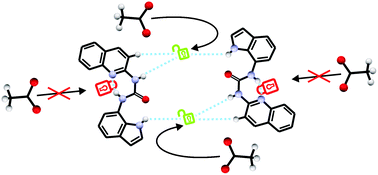Non-symmetric substituted ureas locked in an (E,Z) conformation: an unusual anion binding via supramolecular assembly†
Abstract
Two new asymmetric ureidic receptors L1 (

* Corresponding authors
a
Universita' degli Studi di Cagliari, Dipartimento di Scienze Chimiche e Geologiche, S. S. 554 Bivio per Sestu, Monserrato, CA, Italy
E-mail:
ccaltagirone@unica.it
Fax: +39 0706754456
Tel: +39 0706754452
b
School of Chemistry, University of Southampton, Southampton, UK
E-mail:
M.E.Light@soton.ac.uk
Fax: +44 (0)23 8059 6805
Tel: +44 (0)23 8059 6805
Two new asymmetric ureidic receptors L1 (

 Please wait while we load your content...
Something went wrong. Try again?
Please wait while we load your content...
Something went wrong. Try again?
M. Olivari, C. Caltagirone, A. Garau, F. Isaia, M. E. Light, V. Lippolis, R. Montis and M. A. Scorciapino, New J. Chem., 2013, 37, 663 DOI: 10.1039/C2NJ40877E
To request permission to reproduce material from this article, please go to the Copyright Clearance Center request page.
If you are an author contributing to an RSC publication, you do not need to request permission provided correct acknowledgement is given.
If you are the author of this article, you do not need to request permission to reproduce figures and diagrams provided correct acknowledgement is given. If you want to reproduce the whole article in a third-party publication (excluding your thesis/dissertation for which permission is not required) please go to the Copyright Clearance Center request page.
Read more about how to correctly acknowledge RSC content.
 Fetching data from CrossRef.
Fetching data from CrossRef.
This may take some time to load.
Loading related content
